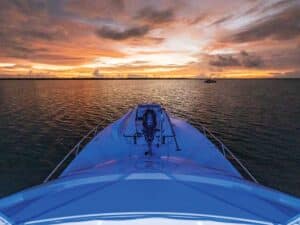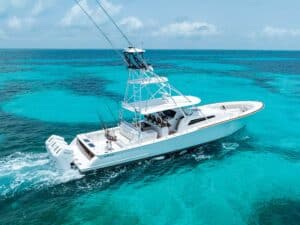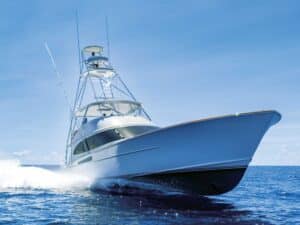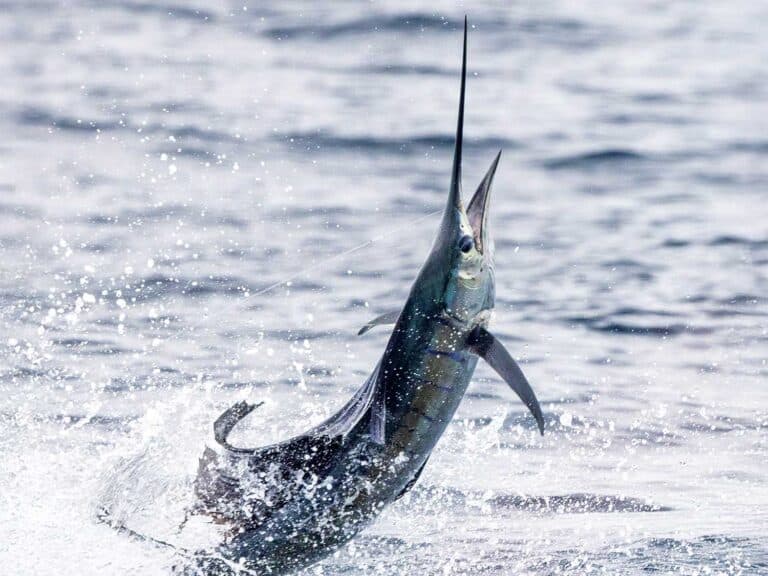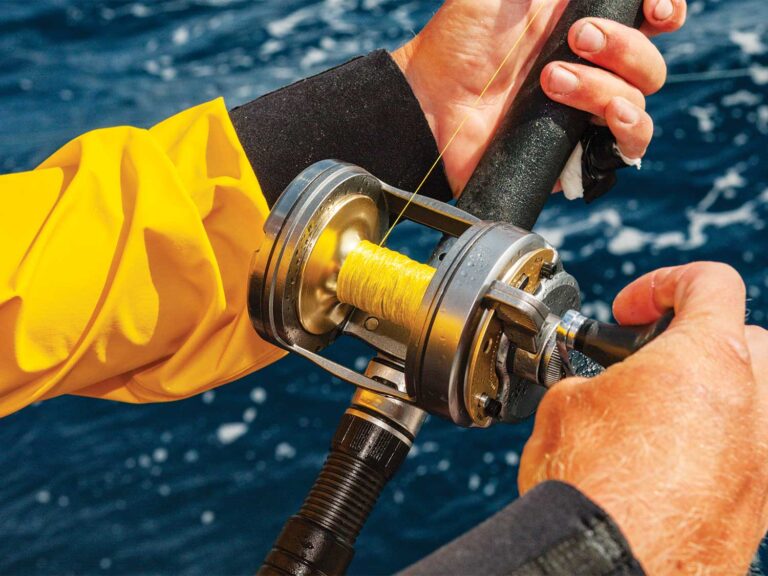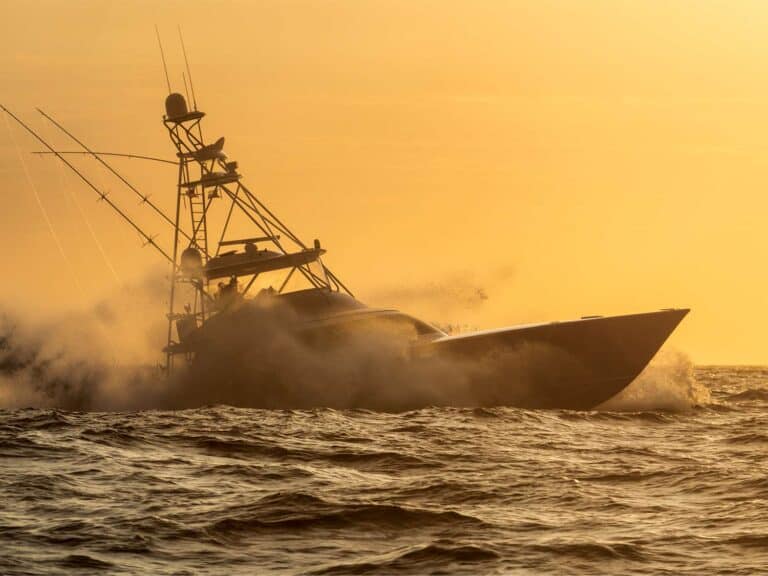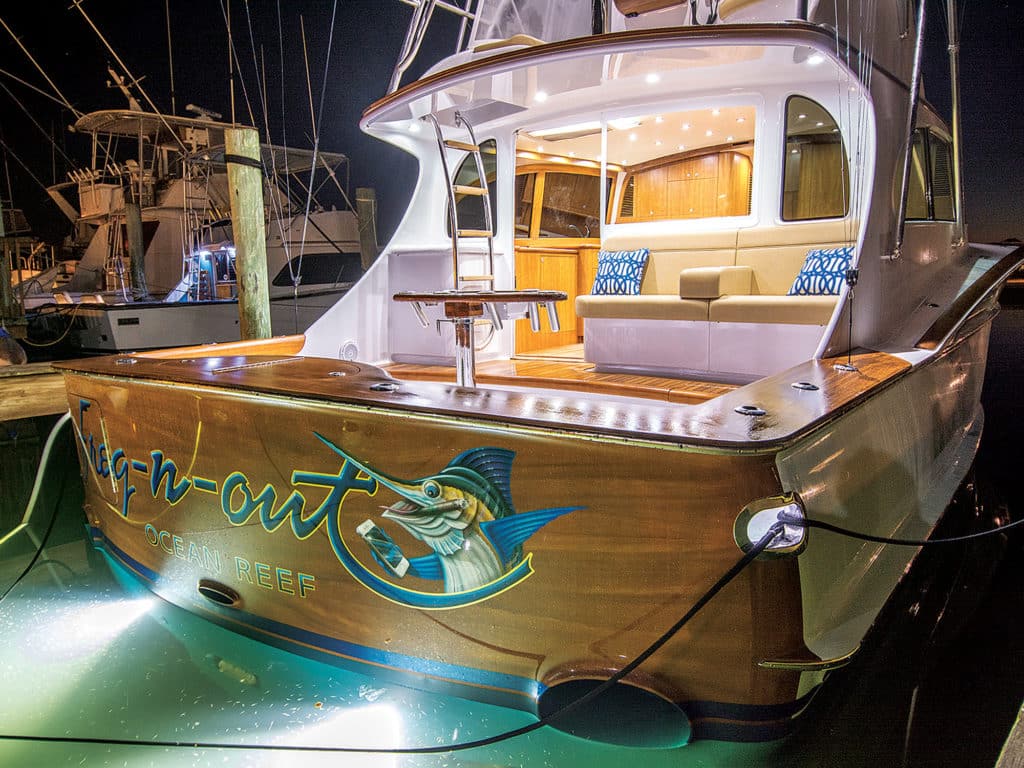
Take a look at the transoms of some of the sport-fishers the next time you walk the docks: Can you tell the difference between a painted faux teak transom and one made from the real thing? My guess is that unless you look closely at some of the latest works from a handful of marine artists, you won’t be able to tell the difference — I know I couldn’t the first time. One of those talented artists is Josh Everett from Everett Nautical Designs, so I spent some time picking his brain about the rise in popularity of painted faux teak and some of its advantages.
The Supply Shortage
One of the biggest obstacles boatbuilders face today is the availability of quality teak. It’s not just isolated to the boatbuilding industry either: Furniture manufacturers and homebuilders are experiencing the same predicament. Everett explains: “The wood availability now is not nearly what it was, even, say, 10 years ago. When I left the boatbuilding industry working for Bayliss, we were very particular about pulling stock for things like covering boards and transoms. Ideally, we’d get a giant piece of 16/4 lumber and then re-saw it and do the whole transom out of one board.”
The same is true for bulkheads. Everett personally laid the teak on Brooks Smith’s Uno Mas — hull no. 1 from Bayliss Boatworks that splashed in 2003 — and built it from one tree, bookmatching it from top to bottom. But quality wood was available then. “Now, these guys are going to pull covering-board stock from teak boards and are having a tougher time,” says Everett.
Everett also made a name for himself by doing transom artwork for several boatbuilders. That line of work led the way for his current endeavor, when Spencer Yachts asked if Everett would be interested in doing faux teak paintwork. He had never done it before, but they challenged him to see what he could do on one of their builds, the first of which was Callie Girl in 2007.
Durability is Key
Everett always uses Awlgrip paint to create his woodlike finish. The main benefit, aside from cost, is that it doesn’t require the maintenance of varnished wood. “The Awlgrip product has a very durable finish, and we are anticipating the product will last 8 to 10 years, essentially the same life as other yacht finishes,” says Everett. “This could be extended for boats that have a good maintenance program.”
We all know things happen when captains back down on a fish: you get bill scratches or even gouges in real teak transoms from hot fish or an errant gaff. Damage to faux teak from these occurrences isolates itself to the affected areas only. Conversely, on a real teak transom, much more damage can be done below the surface. “If you take a really good shot from something offshore, the hermetic seal of the transom surface can be broken and moisture can get behind that layer and migrate — basically becoming cancerous,” says Everett. “This is when you will see blisters and significant water damage on a transom, especially if the boats don’t come out of the water or if they aren’t getting sealed out in the field.
“With faux teak, you are using Awlgrip paint. If you scratch paint, it’s not like the water can get behind it and migrate anywhere else. With the painted finish, it’s just a matter of touching up the area.”
Captains who like to maintain flawless finishes can keep a small bottle of Everett’s brown base color on hand so they can mix up a little bit and apply it with a small artist’s brush.
Bad Experiences
While Everett has not experienced any delamination or release issues on any of his faux teak work, he has seen other jobs with these issues. However, he says those things can be avoided by using high-quality paint and meticulous attention to detail. “It’s in how you do your prep work, making sure there are no shiny surfaces so that you are getting the correct mechanical bond and that the hardware has been removed and degreased,” says Everett.
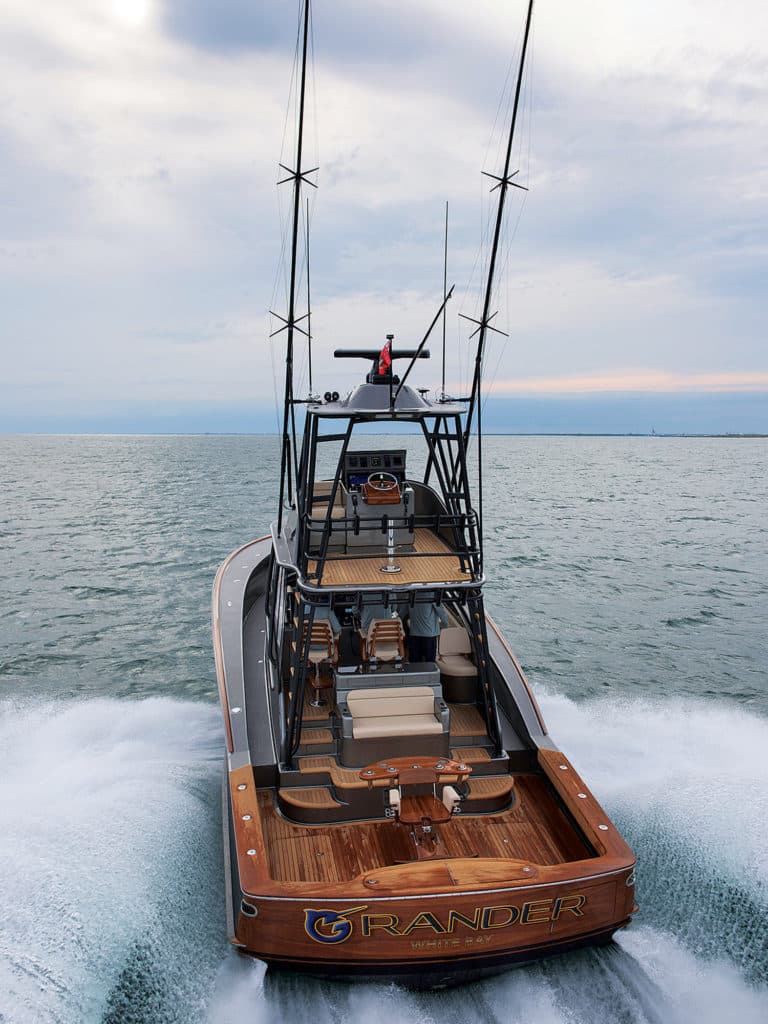
The Process
The average fiberglass transom takes Everett three to four days to paint, but it all depends on the boat’s size and shape. Most transoms traditionally constructed from teak take three or four separate planks and a piece of molding at the shear guard, as well as some moldings around the exhaust. Sometimes they’ll have through-hulls or other unique features, so Everett conceptualizes the different aspects of the hull in pieces as if he were actually constructing the transom from teak. “I never paint two planks that are next to each other the same way. I isolate them to give each plank a very distinct look and then I’ll bookmatch them, so the amount of time it takes to do a job is really based on the amount of planks and individual pieces you’re working with,” says Everett.
Much of this transom work also depends on the boat and the shape of the transom. Take a build from Winter Custom Yachts or the recent Grander from Jarrett Bay and you can see that they have a very rounded transom at the corners in addition to tumblehome. There’s an extra element added to those builds because Everett must break them up to the proper joinery.
When Everett works on a full aft bulkhead, with mezzanines, cabinetry, moldings, wings and everything else, he has to think of how he would cut that into individual pieces as if he had constructed it, rather than painted it. This can turn out to be a lot of different pieces — 40 or 50 planks or more — and they are quite extensive. Each plank has to have its own unique characteristics and look as if it came from the same tree.
What to Consider
“Some of the builders are becoming really big on matching finishes from tip to turn on a vessel, so full packages are becoming a thing where every piece of brightwork is being replaced with faux finish — toe rails, half-round, helm pod, salon door, full aft bulkhead, transom — and nothing on the exterior of the boat is real wood,” says Everett. However, some builders remain purists, while others are having Everett use his faux teak finish only on low-visibility areas, like half-round and toe rails, to reduce maintenance needs.
Everett also explained how he could turn up or down the amount of detail that goes into a particular area, especially in high-visibility areas. The viewing distance for a transom is usually from the dock, typically 3 to 4 feet away, so artists have a little more leeway with the level of detail there. But with other high-visibility areas of the boat, like a cockpit or a helm pod, people are constantly close to those areas, so the amount of detail needs to be greater. “A captain has to really like the look of the helm pod because he’s going to look at it every day,” says Everett. “If you don’t do a good job and he doesn’t like it, then you’re going to hear about it from him.
“I know I spend hours in the cockpit, inspecting finishes of both real or faux teak. It’s just the artist in me, but I know I must strive to be extremely accurate — especially in those high-visibility areas — if you want to have a really good replica of the real thing,” says Everett.
While Everett’s work truly takes a fine eye to distinguish if it’s a faux finish, “I still don’t feel that I’ve achieved my final technique yet, especially when I study real teak,” says Everett. “I believe the whole process feels infantile with where it really could be and the direction it is heading. It’s just like boatbuilding: Look at the Rybovich family, with generations of trade and knowledge they passed down. There will be an evolution.”
Helpful Links
Visit the Everett Nautical Designs Faux Teak Painting website for more information.

